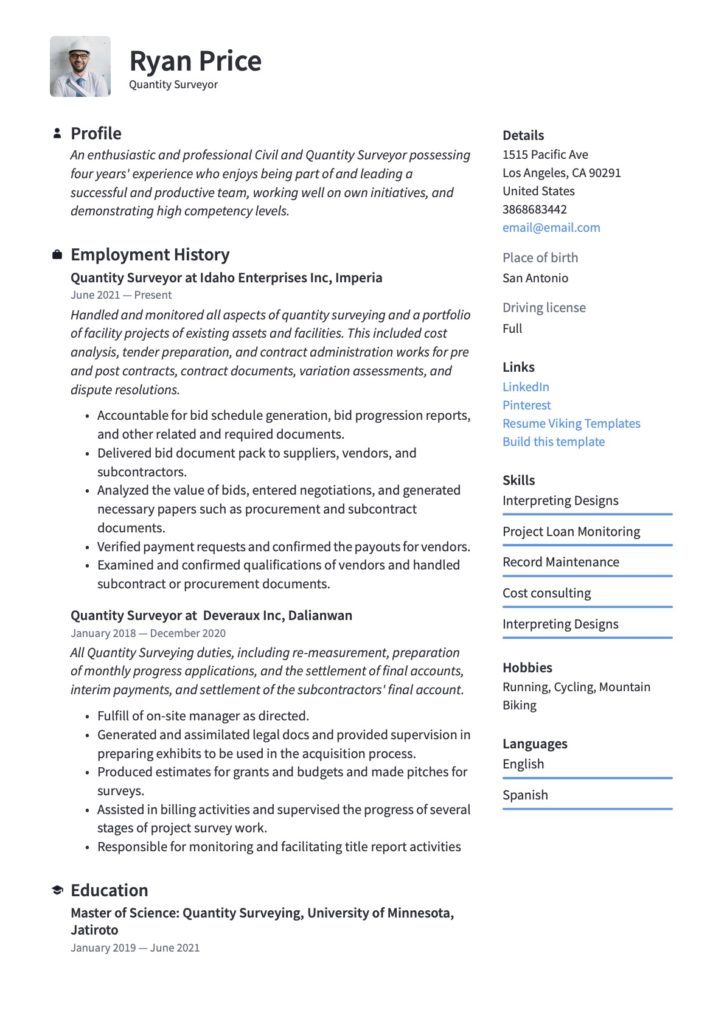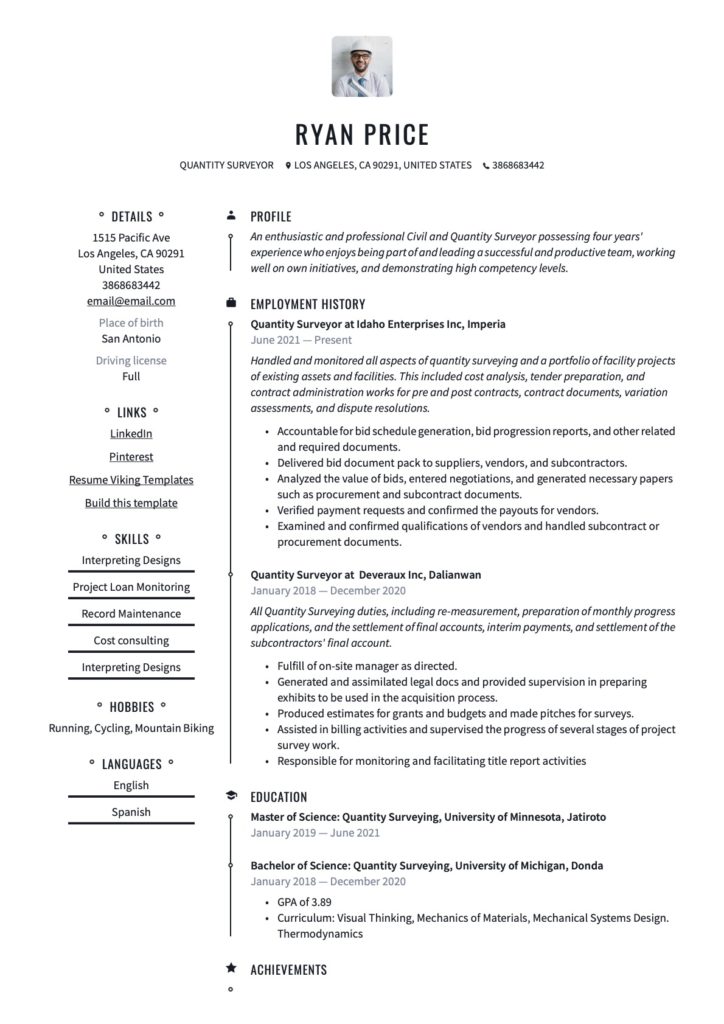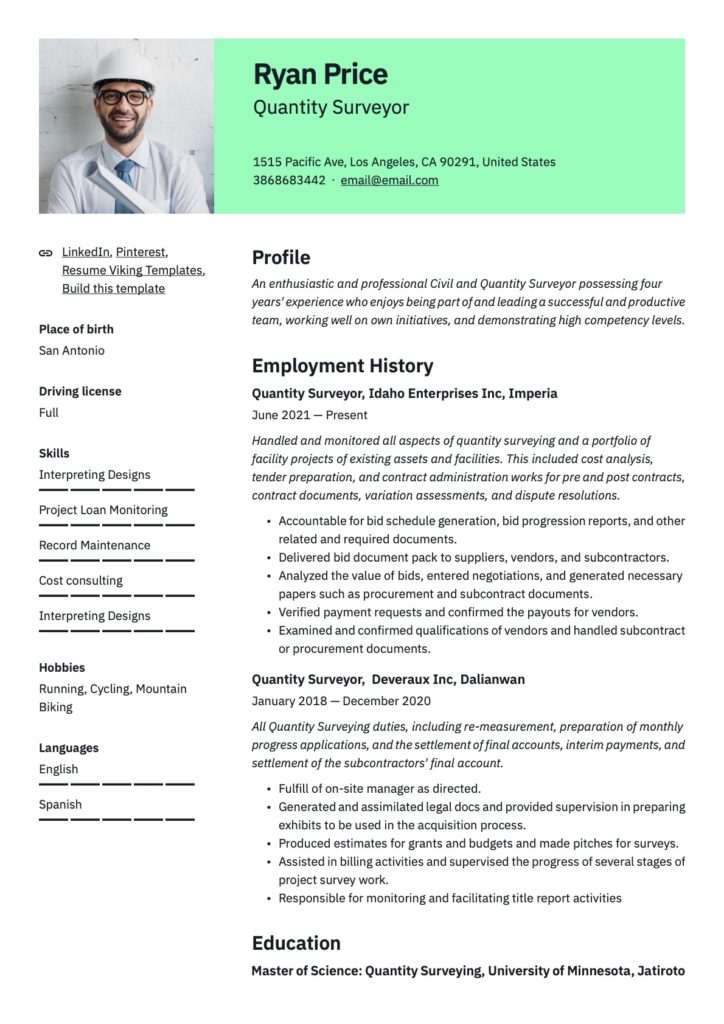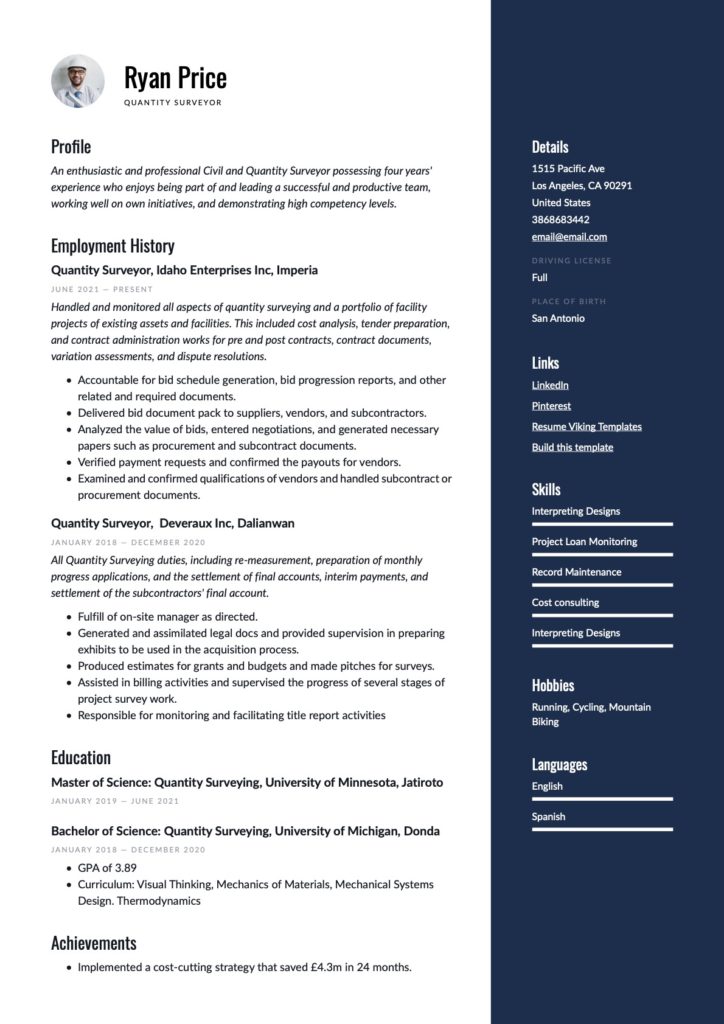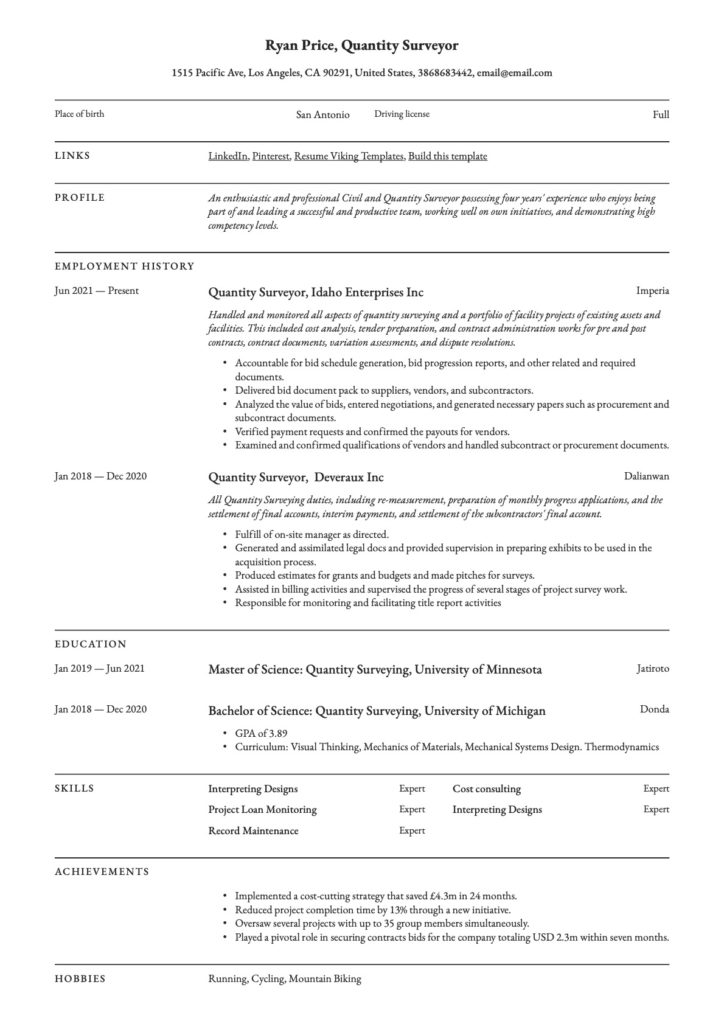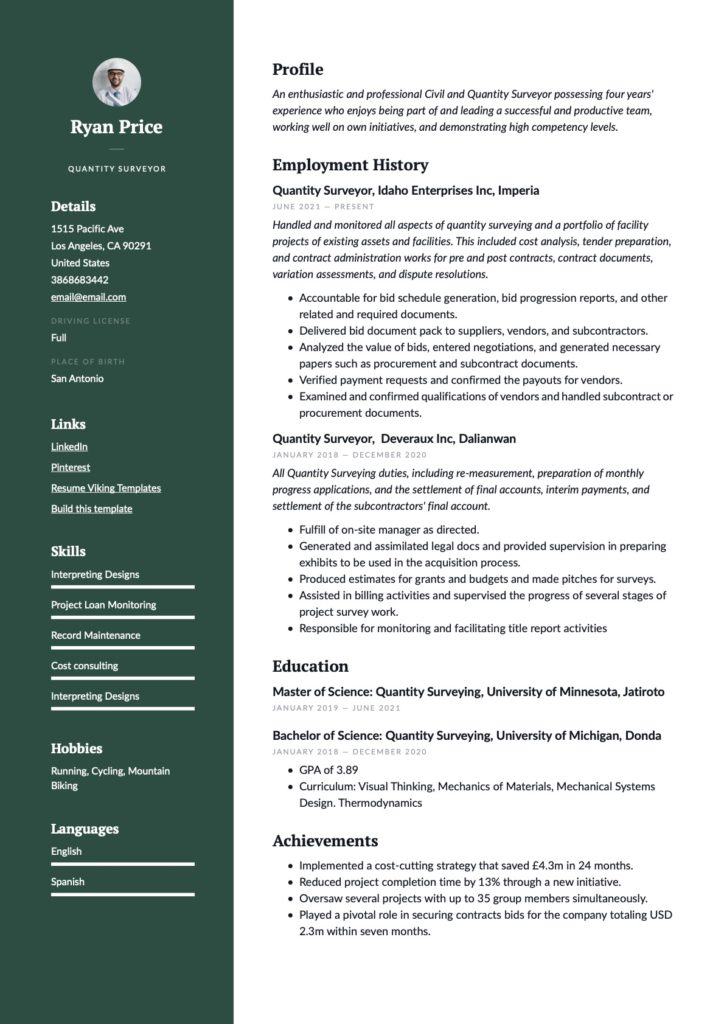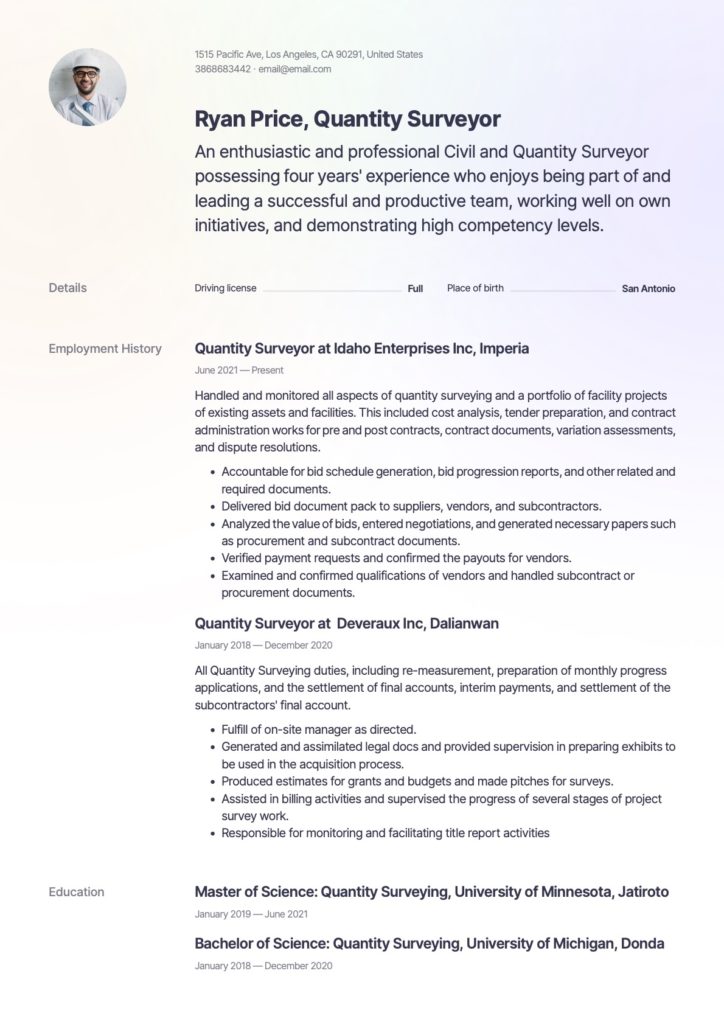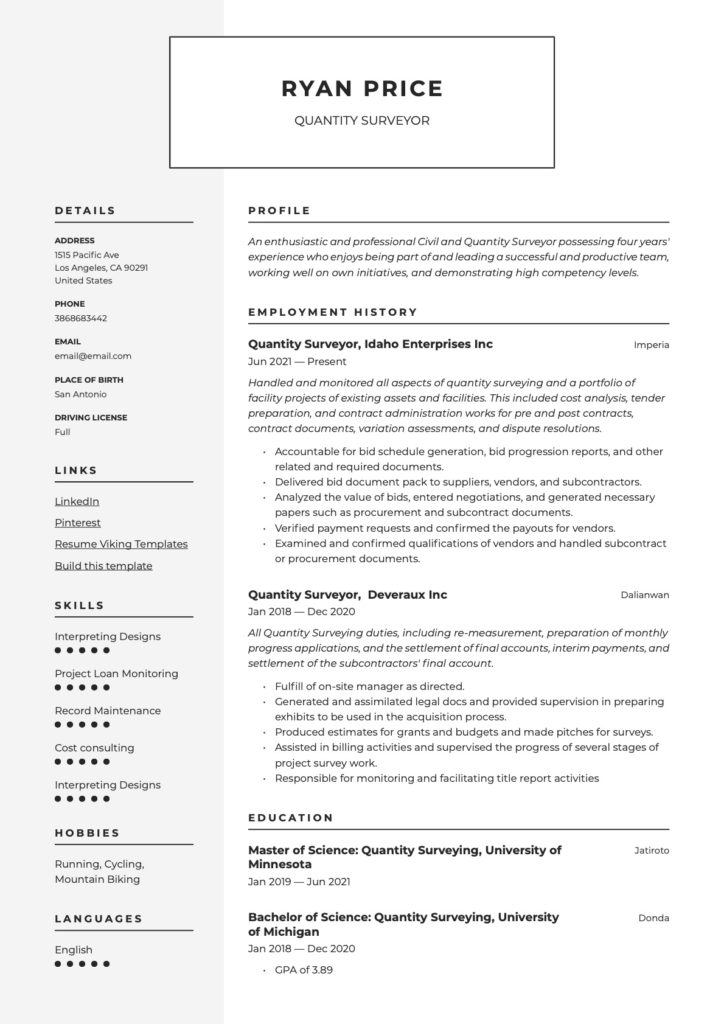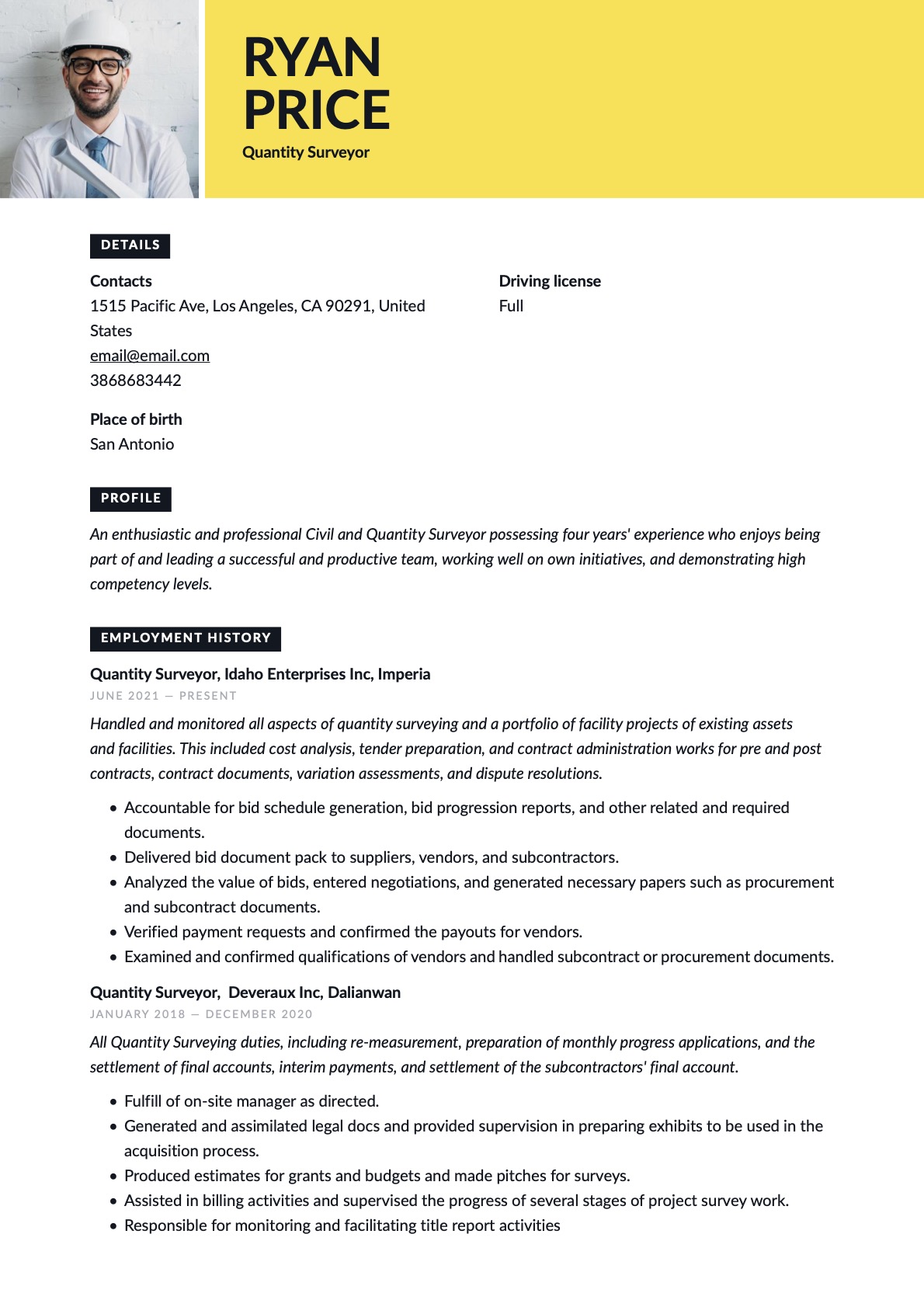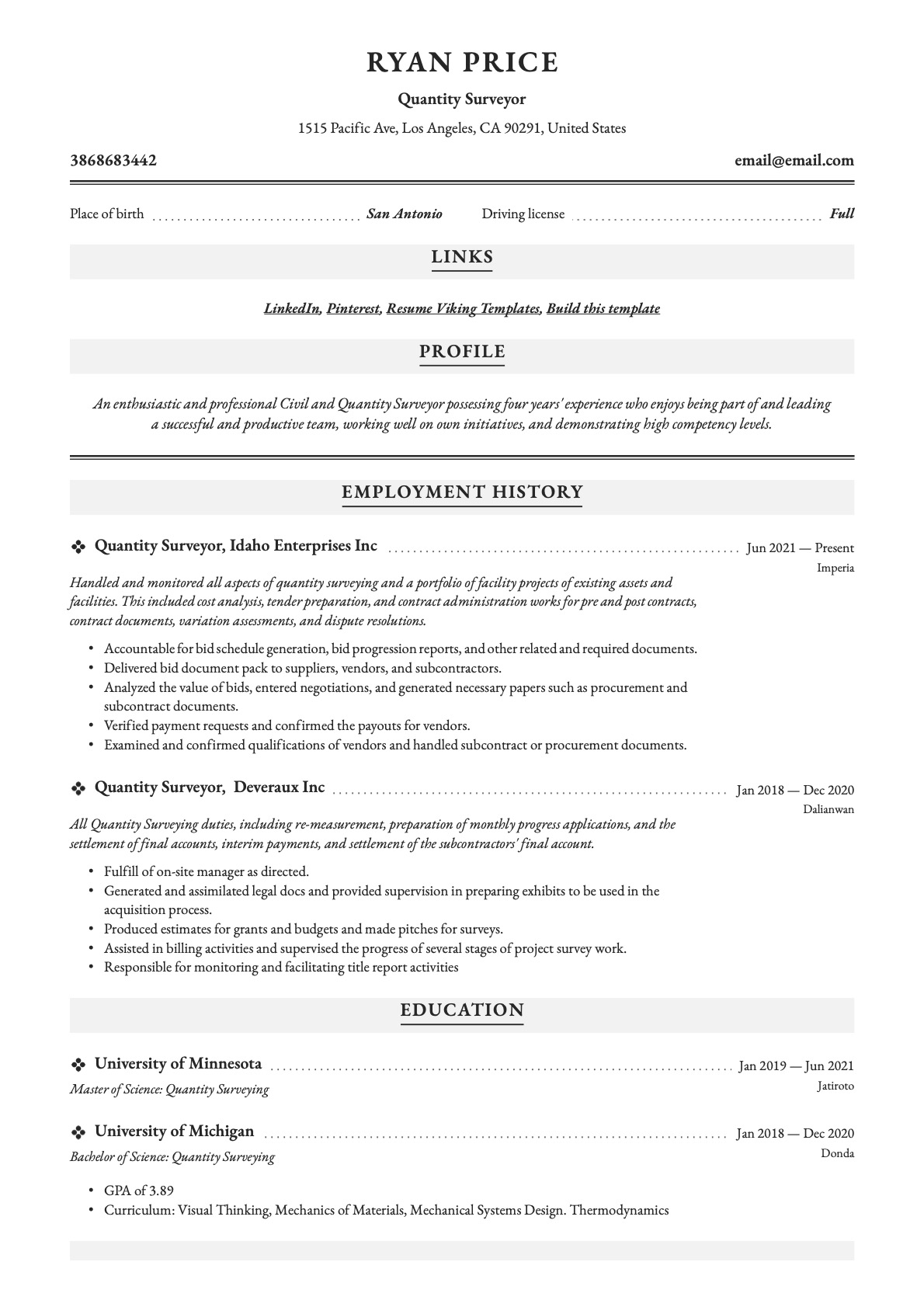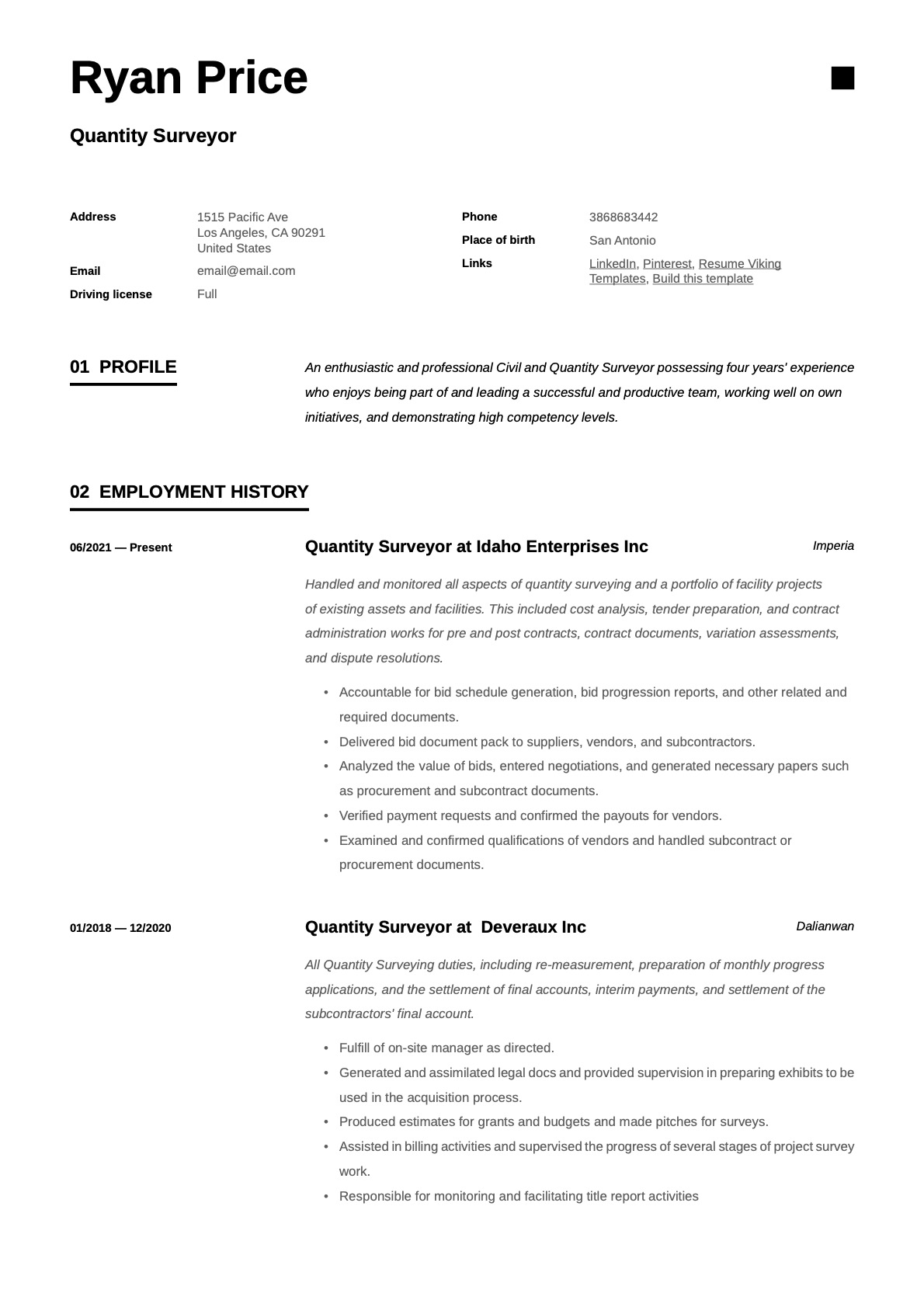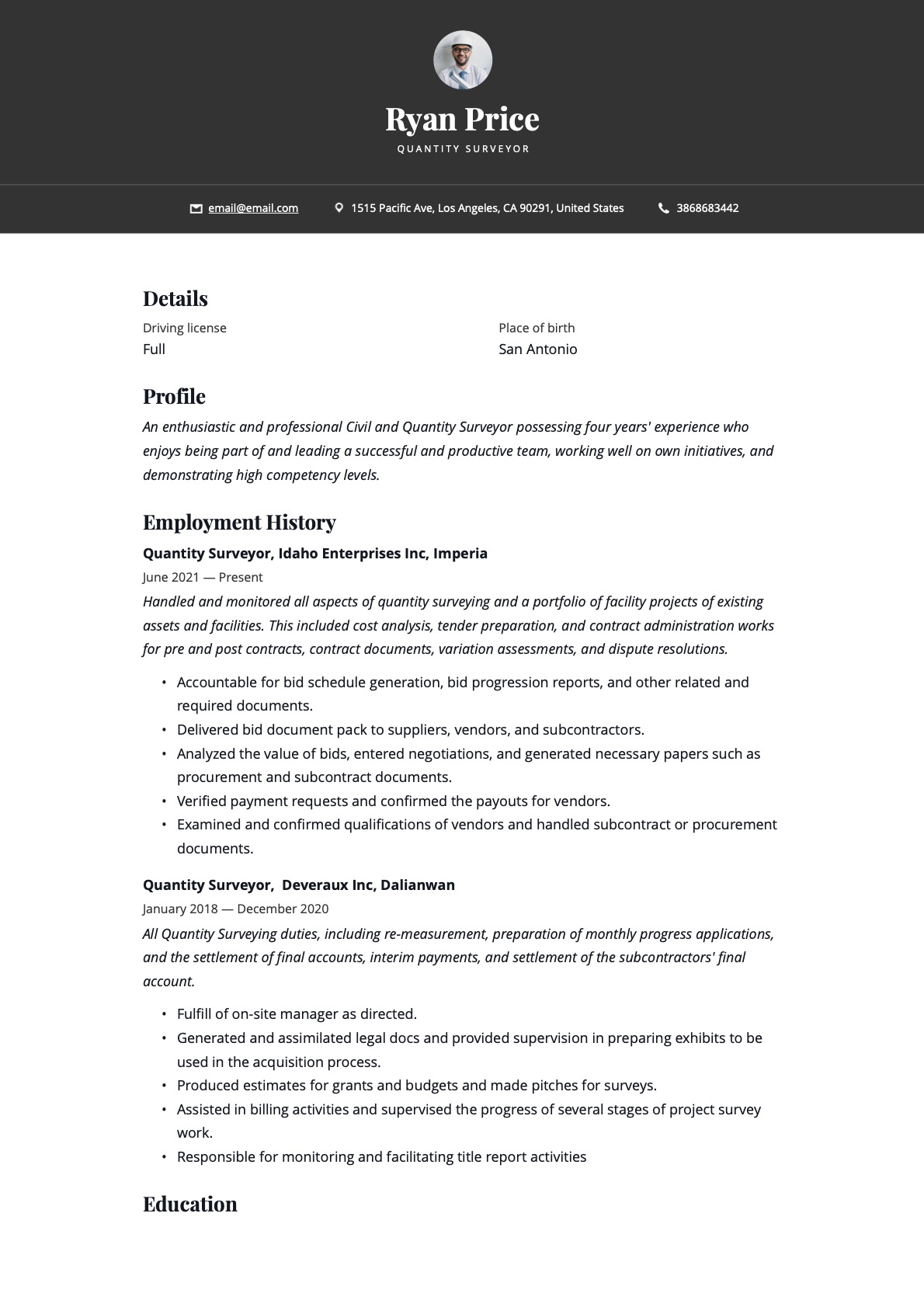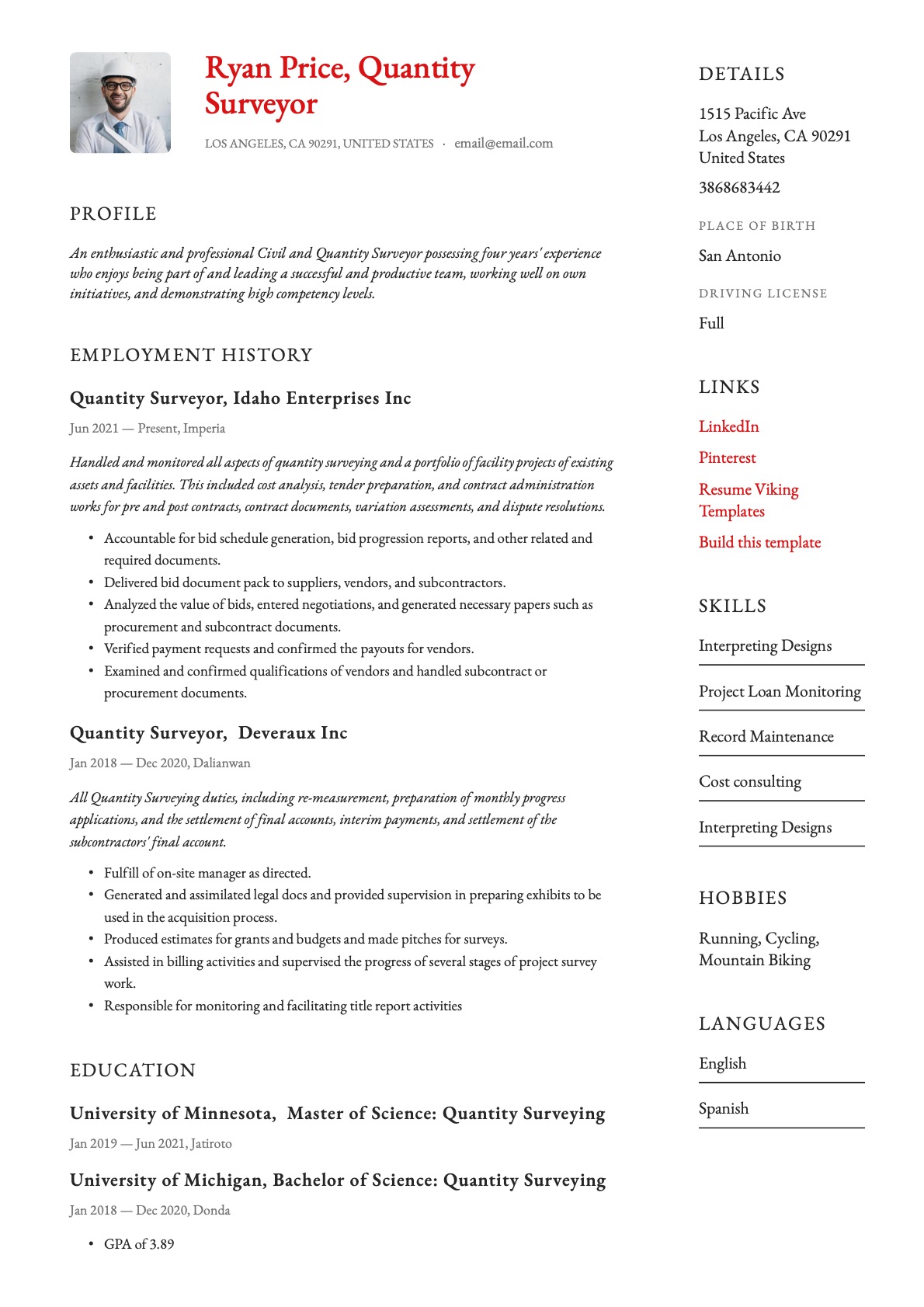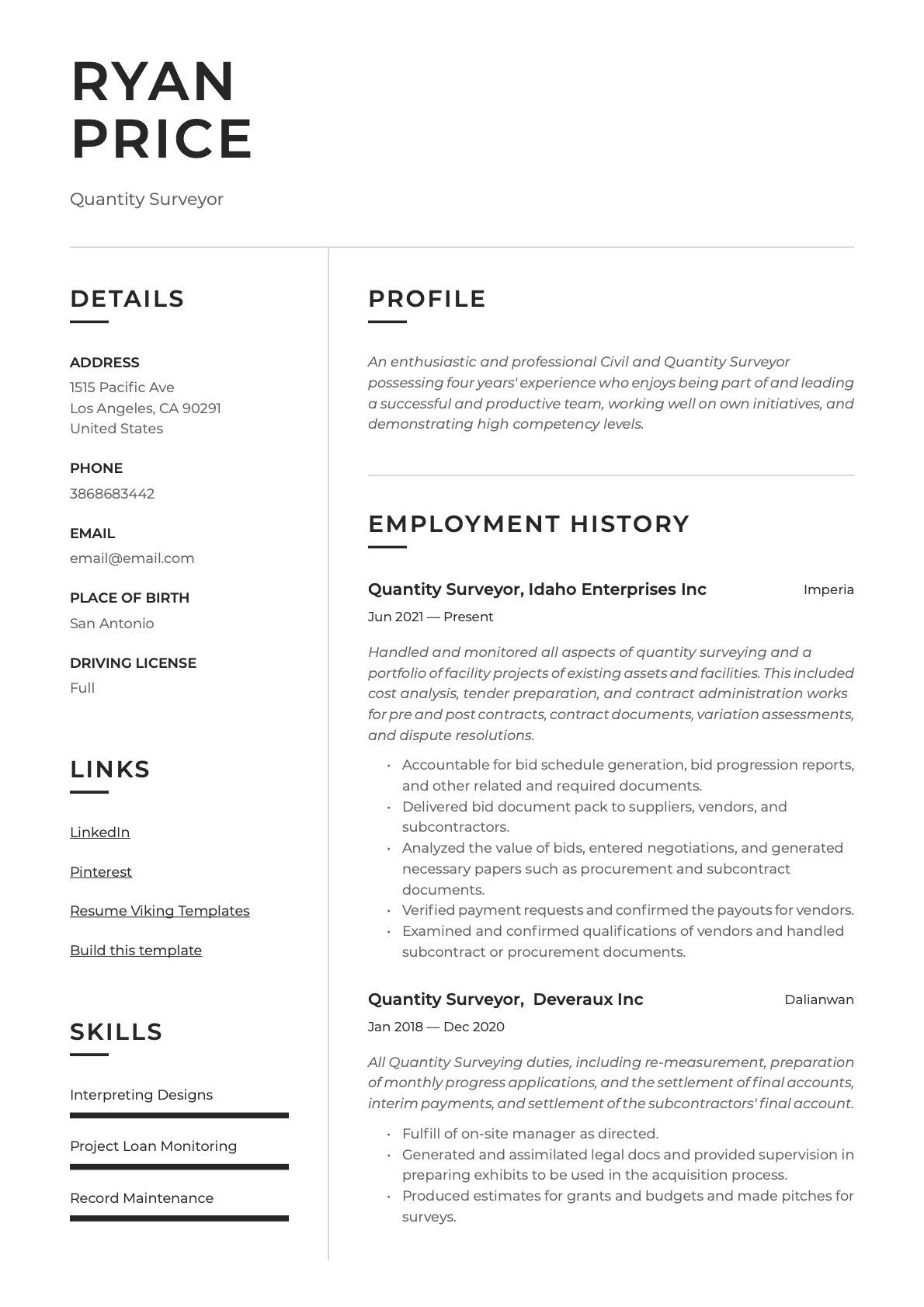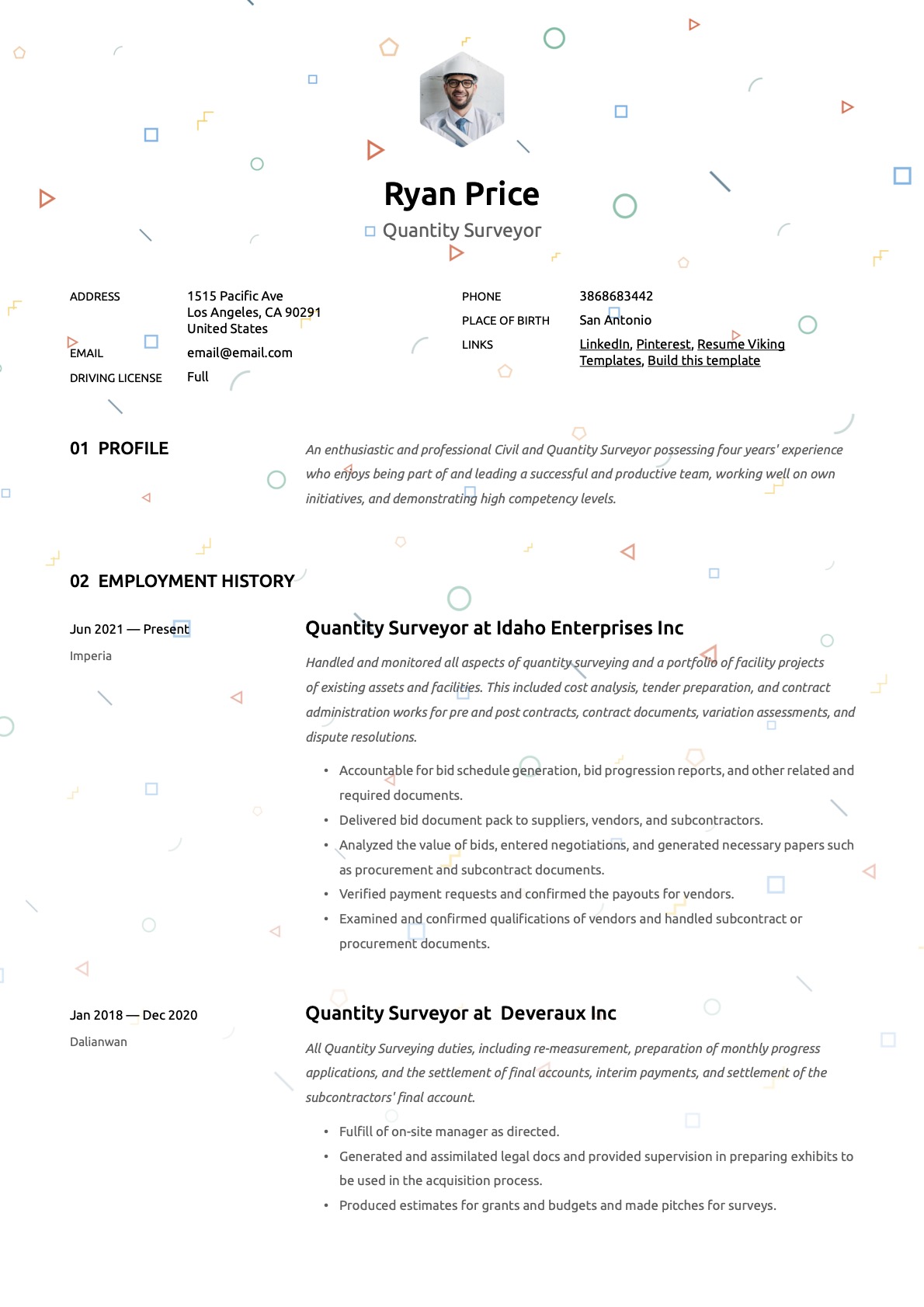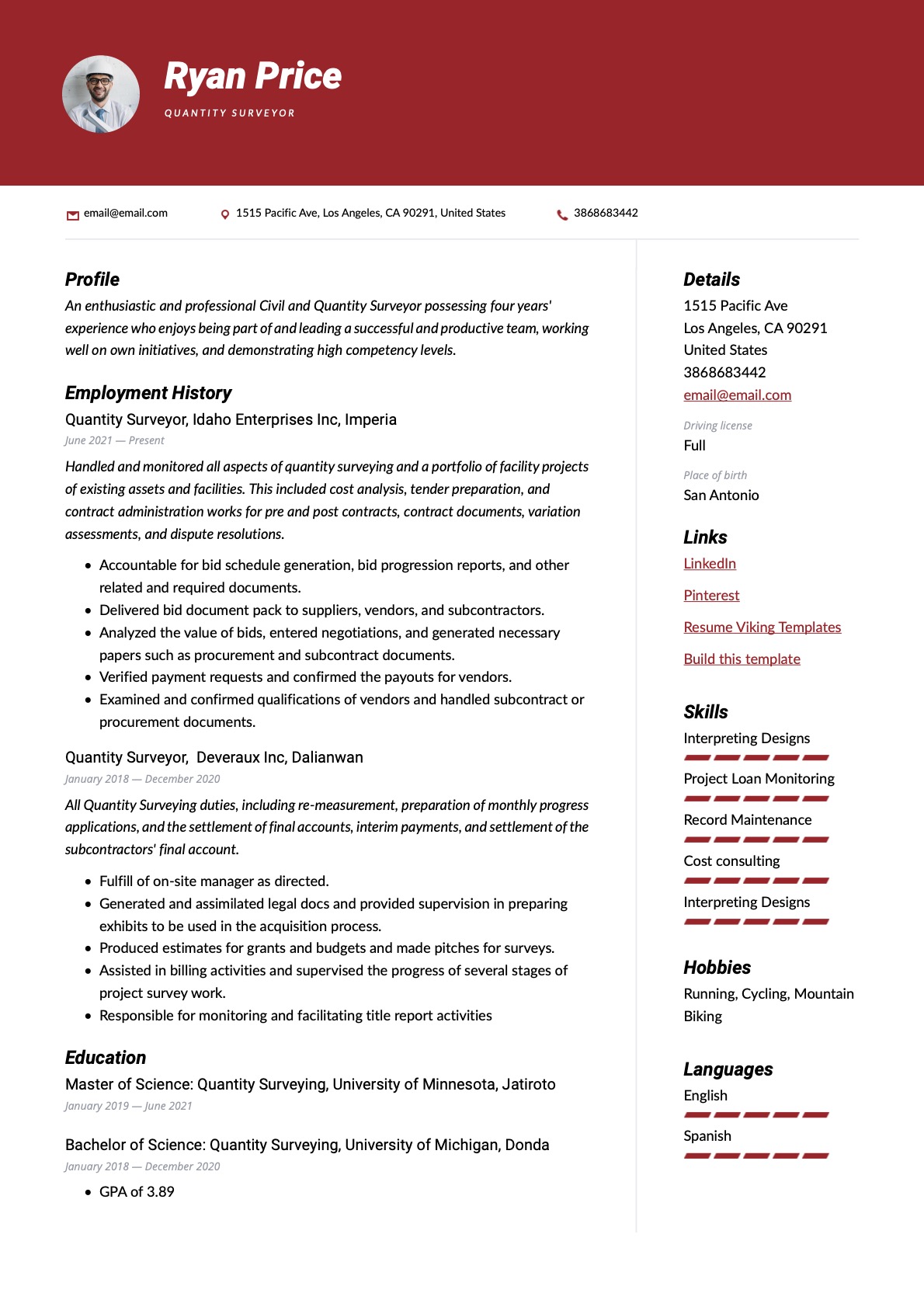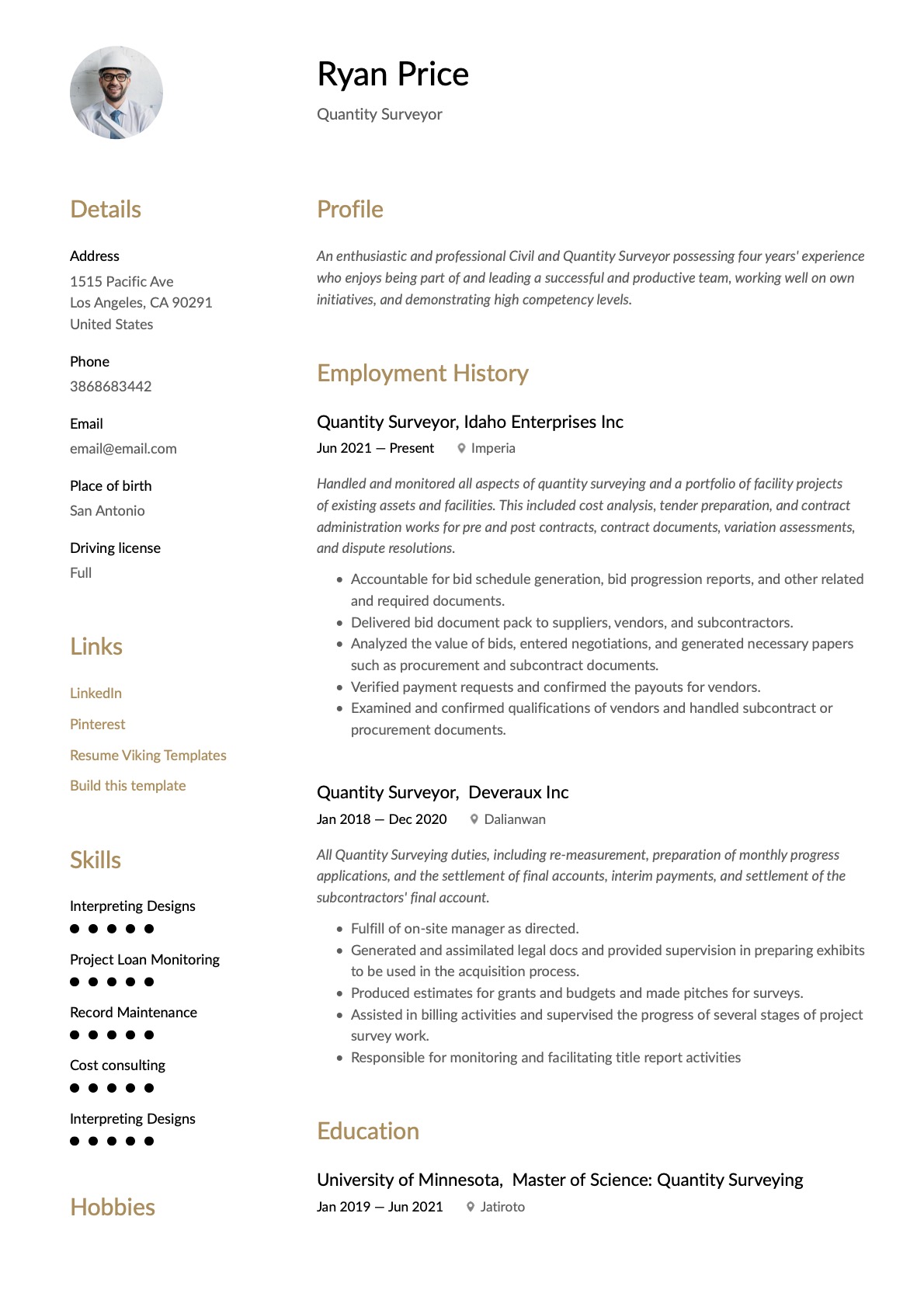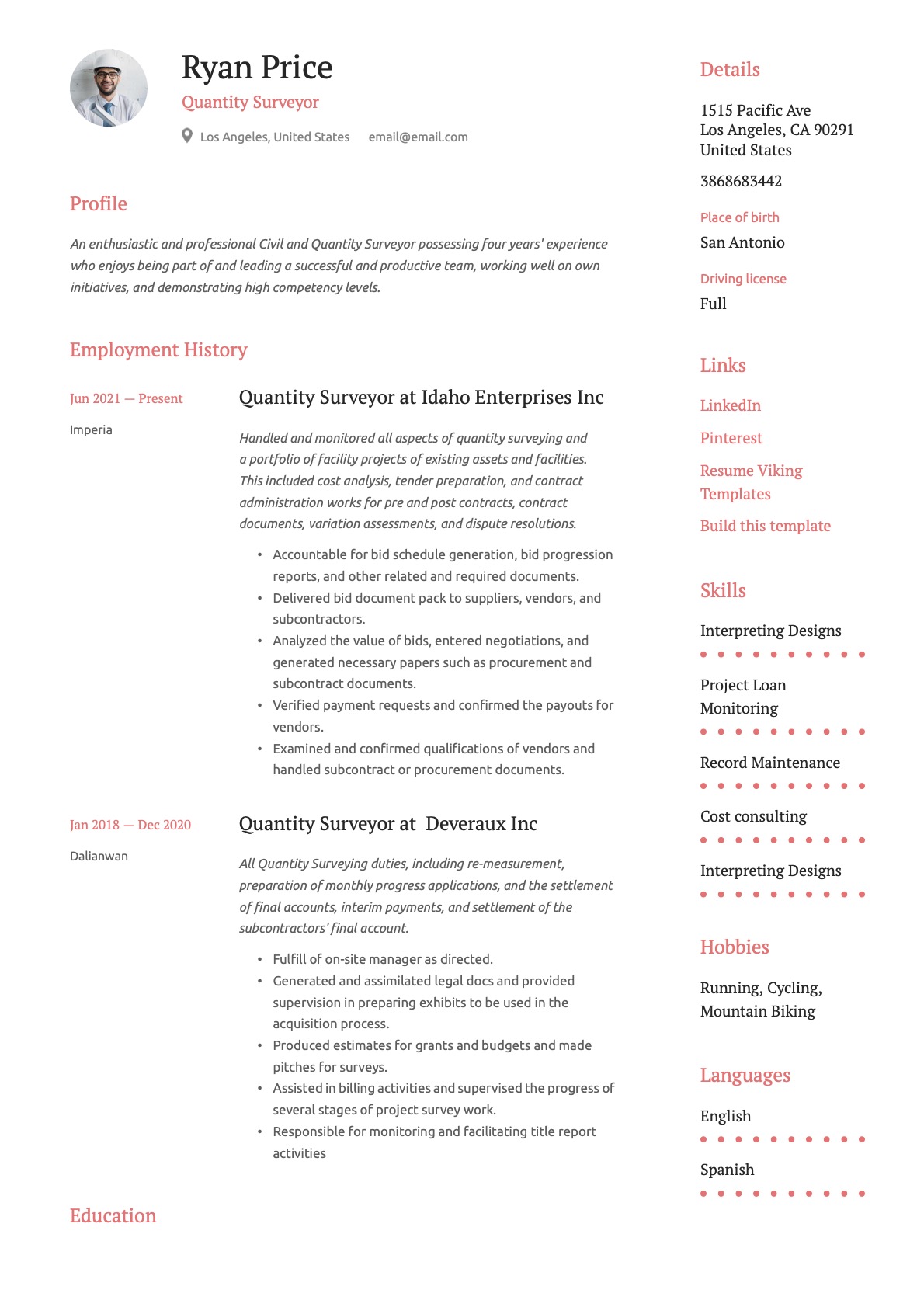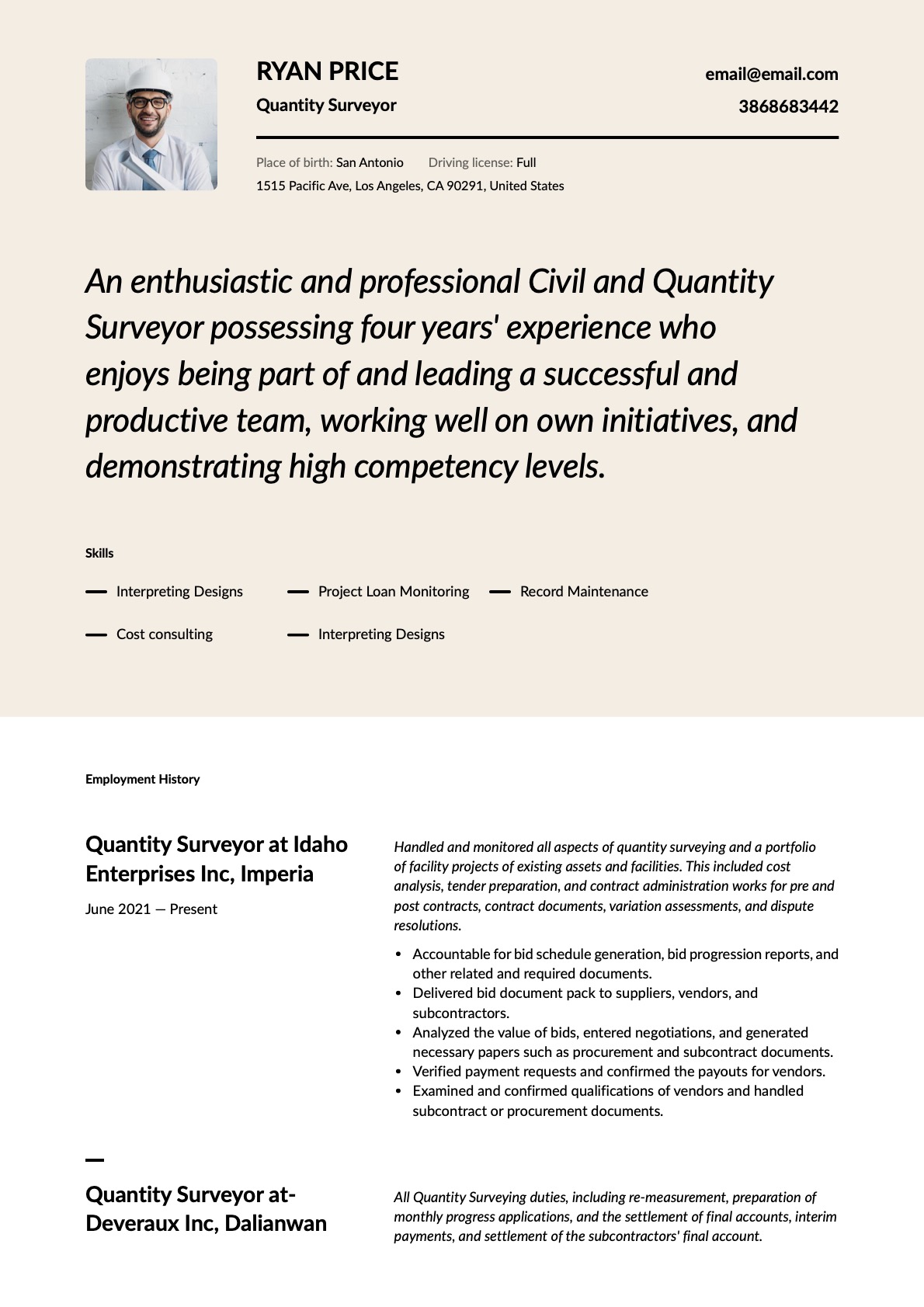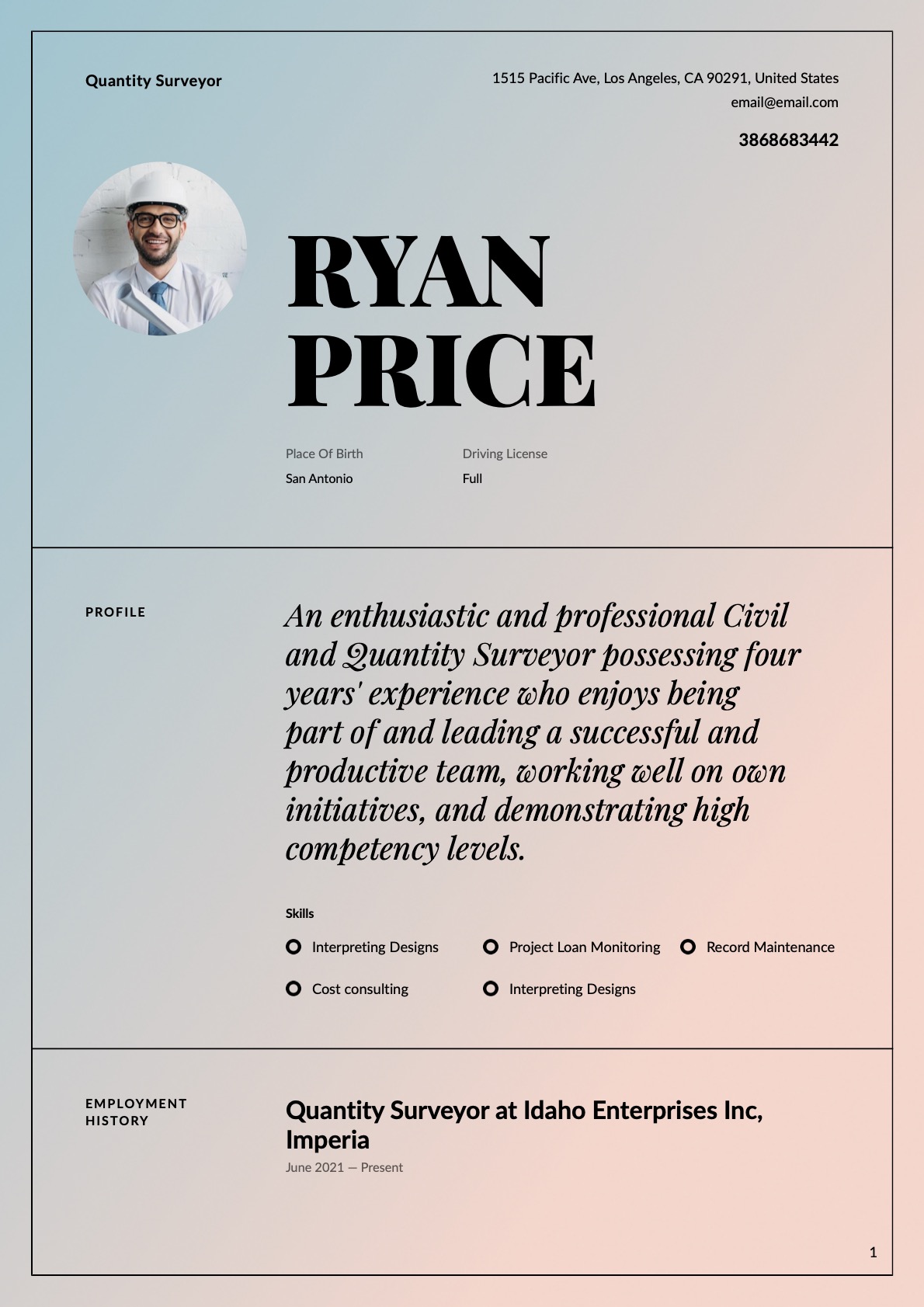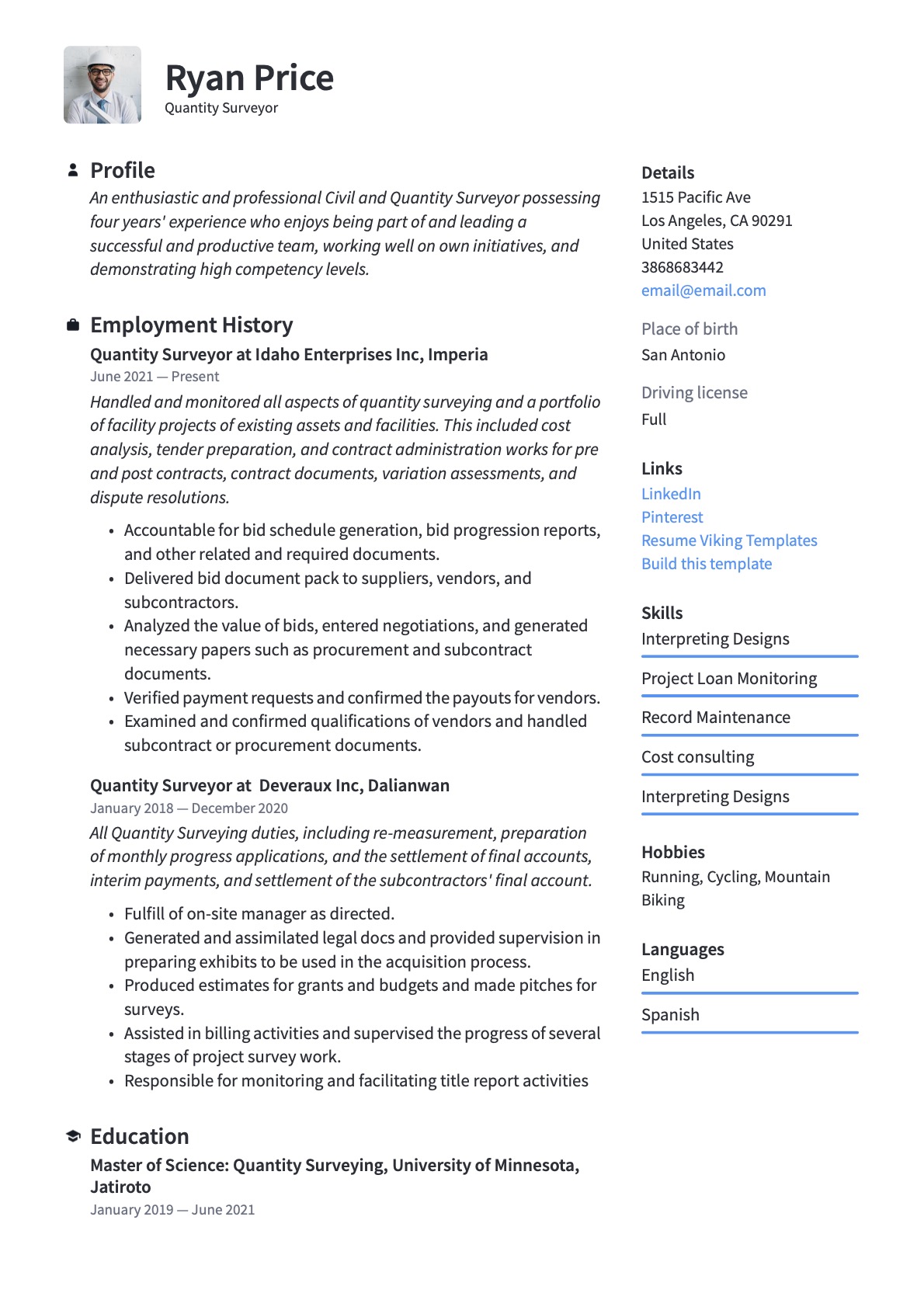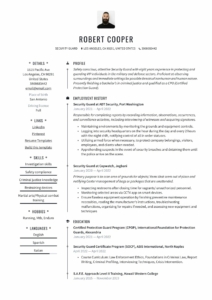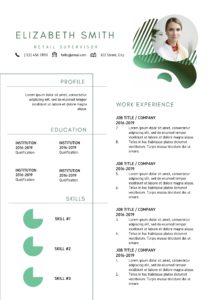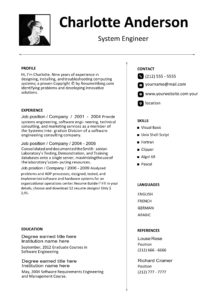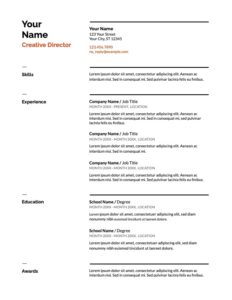If you are looking for your next Quantity Surveyor challenge, you have come to the right place. Together with our high-quality Quantity Surveyor resume samples, we will show you how to create the perfect resume with the capability of landing an interview.
In this write-up on how to compile a Quantity Surveyor Resume, you will gain access to guidelines, tips, and examples to assist you in creating a noteworthy application that will instantly grab the attention of recruiters and hiring managers.
What you can read in this article
20 Quantity Surveyor Resume Examples
(Free sample downloads are at the bottom of this page)
Quantity Surveyor Resume Writing Guide
Resume Sections
- Contact information
- Career Objective & Summary
- Employment History
- Achievements
- Education
- Skill Section
- Certification & Licensing
- Extras: Languages/Awards/Publications/Volunteering/hobbies
- > Professional information
1. Contact information
- First Name and Last Name
- Physical Address
- LinkedIn Profile / Portfolio Link
What to Highlight as a Quantity Surveyor
Your main goal when writing your resume is to grab the reader’s attention, and as much as possible trying to achieve this from the very first section. Hiring managers must look through hundreds of resumes, each with much the same information, so the trick is to list your information so that it is not generic and makes the reader want to read on.
When it comes to writing your Quantify Surveyor resume, it does not matter whether you have years and years of experience or have just started. However, every employer must see a few crucial pieces of information in an applicant’s resume. Below we have outlined this detail:
Firstly, you need to highlight your primary purposes and daily functions that are required of you. Typically, Quantity Surveyors are required to manage project costs, conduct feasibility studies, coordinate work efforts, prepare and analyze costs for tenders and contracts, provide legal and contractual advice, value completed work, arrange payments, identify potential risks, allocate work to sub-contractors, and analyze outcomes.
If you have had to do any of these above examples and more, ensure that you clearly state this.
Secondly, to gauge your competency, hiring managers and employers want to see the types of projects you have had to complete in the past.
Due to Quantity Surveyor projects being so diverse, simply include specific pieces of information that allow the reader to gauge the size of the project, both physically and financially.
Finally, provide facts and figures to show how you could maximize efficiency and allowed your role in the project to run smoothly.
Lastly, place specific emphasis on the following:
- Any particular instances that highlight that you are fully qualified for dealing with on-the-job crises.
- Your ability to describe job requirements as you understand them.
- How interpersonal relations relate to your job as a Quantity Surveyor.
- What makes you so sure that you are suited to this career.
- Do you see yourself working in the same position for the next five years, or do you wish to rise in the ranks?
2. Career Summary & Objectives
A career summary/objective can be thought of as your resume’s introduction. It serves a very specific purpose: instantly communicating your potential value and proven capabilities to the reader. Your career summary should not be more than 5-6 lines in length and should be as concise as possible. Remember, this is only an introduction.
Below we have mentioned a few points to remember:
A few do’s and don’ts to remember:
- Do mimic the verbiage in the job offer.
- Don’t have too much jargon.
- Do spell out names in full.
- Don’t use too many descriptive nouns.
Right about now, you may very well be asking yourself whether you should choose a career summary or a career objective, do not stress, we will help you choose:
- If you are an experienced Quantity surveyor with more than two years of experience, a career summary is a choice for you. It will allow you to sum up your experience while still highlighting your skills, qualities, and qualifications.
- Alternatively, if you are just starting and have less than two years of experience, a career objective is a better choice. Here, instead of highlighting your experience, a career objective allows you to highlight your career goals and aspirations while simultaneously highlighting your impressive skills, qualities, and experience.
Considering that you are a Quantity Surveyor, approach the compilation of your summary like you would approach a project… in stages:
- Stage 1: Start with a compelling personal trait/verb and then the job title you held.
- Stage 2: Provide your years of experience.
- Stage 3: State the main purpose of your job and integrate this with two special competencies.
- Stage 4: List your highest degree, certification or qualification attained.
Examples
Quantity Surveyor Summary 1
“An enthusiastic and professional Civil and Quantity Surveyor possessing four years' experience who enjoys being part of a productive team, working well on own initiatives, and demonstrating high competency levels.“
Quantity Surveyor Summary 2
“A Quantity Surveyor with about six years of experience in project planning and implementation, project procurement, Management, cost control and analysis, contract management, and preparation of contract documents. Negotiated an agreement with subcontractors on-site and was involved in the ordering and procurement of materials.“
Quantity Surveyor Summary 3
“Licensed Quantity Surveyor for specialization in all aspects of Quantity Surveying, including material takeoff, cost plan, contract management, bill of quantity preparation, and the preparation of billing/claims.“
Quantity Surveyor Summary 4
“QS who prepared materials and quantity takeoff of structural, architectural, and external work quantities. Prepared cost controls and budget allocations, monthly progress claims, and variations/change orders.“
3. Employment History & Examples
We will mention this several times throughout this guide, but before you start writing a new section, ensure that you clearly understand what has been said in the job description. This will allow you to tailor your information to reflect exactly what the employer is looking for. Now, when it comes to your employment history, there are many ways to get the most out of your information.
- List your employment history in reverse chronological order to allow the reader to view your most recent experience first.
- Begin by stating the job title you held, followed by the name of the company or organization you worked for, and lastly, your employment dates.
- Add 4-5 bullet points that highlight the main responsibilities and duties you were given. Ensure that you include quantification to make your statements relevant.
- Aside from your software and technical knowledge, make sure to mention that you have strong, soft skills. Show how you were able to use these skills to maximize team efficiency or communicate effectively with clients.
Quantity Surveyor at Idaho Enterprises Inc.
(December 2017 – Current)
Handled and monitored all aspects of quantity surveying and a portfolio of facility projects of existing assets and facilities. This included cost analysis, tender preparation, and contract administration works for pre and post contracts, contract documents, variation assessments, and dispute resolutions.
- Accountable for bid schedule generation, bid progression reports, and other related and required documents.
- Delivered bid document pack to suppliers, vendors, and subcontractors.
- Analyzed the value of bids, entered negotiations, and generated necessary papers such as procurement and subcontract documents.
- Verified payment requests and confirmed the payouts for vendors.
- Examined and confirmed qualifications of vendors and handled subcontract or procurement documents.
Quantity Surveyor at Deveraux Inc
(May 2013 – October 2017)
All Quantity Surveying duties, including re-measurement, preparation of monthly progress applications, and the settlement of final accounts, interim payments, and settlement of the subcontractors' final account.
- Fulfill of on-site manager as directed.
- Generated and assimilated legal docs and provided supervision in preparing exhibits to be used in the acquisition process.
- Produced estimates for grants and budgets and made pitches for surveys.
- Assisted in billing activities and supervised the progress of several stages of project survey work.
- Responsible for monitoring and facilitating title report activities
Job Descriptions Samples
A Quantity Surveyor’s career progression is depicted by various stages that provide standardization to job titles and experience levels.
A Junior Stage Quantity Surveyor may:
- Provide detailed records and evaluations of work executed with the application of principles of cash maximization.
- Monitor budgets and provide contract/workstream performance data timeously.
- Develop, maintain, and administer the commercial elements of temporary work schedules and associated Sub-Contractors.
- Assist senior staff in collecting data to monitor individual contract performance on a monthly and quarterly basis.
- Measure and evaluate site work and drawings for valuations, variations, and final accounts directed by the line manager.
A Midlevel Stage Quantity Surveyor may:
- Identify data that should be briefed to Management and workforce through workshops to drive efficiencies.
- Be responsible for work packages and cost management, including forecasting, budget management, and control.
- Provide a key commercial interface for responsible work package management.
- Estimate HVAC piping and equipment work, firefighting system work, and lifts and escalator works strictly as per drawings and quality standards.
- Prepare and analyze project performance management information with commentary every month for Senior Management reviewal.
- Establish and enforce standard management procedures to ensure the capturing change and quantification of work is accurate.
A Senior Stage Quantity Surveyor may:
- P&L reporting, forecast, and risk management robustness.
- Provide support to project managers in managing project costs, risks, and mitigation in line with company risk processes.
- Work in conjunction with executives to assist with office management.
- Assist commercial managers and project managers with advice and contractual support for project issues.
- Assist with the Management of a cost consultancy team.
- Oversee the preparation of monthly management reports/liaison with sub-divisional managers.
- Contract Management and help with drafting and negotiations.
4. Accomplishments
Because of how technical a Quantity Surveyor resume can get, you need to ensure that your vital information does not get lost in translation. Remember, most hiring managers are not familiar with your industry terminology.
You, therefore, need to outline your most impressive accomplishments and communicate them in a way that anyone can understand and further that anyone can see your potential.
Some people are often confused about what they should include in their accomplishments section, so think about anytime you have been able to use your unique skills, qualities, and experiences to save your company money, increase revenue, or secure new clients and contracts.
Once you have thought of these occasions, it is time to add quantification to your statements. Quantification is the single most important piece of information you have to include in your accomplishment statements.
Without it, hiring managers have nothing to measure you against other applicants and are likely to discard your resume right there and then.
Here are examples without quantification (what not to do):
- Implemented a cost-cutting strategy that saved a significant amount of money.
- Reduced project completion time through a new initiative.
- Oversaw several projects with multiple group members at a time.
- Played a pivotal role in securing contract bids for the company.
Now, examples with Quantification (what to do):
- Implemented a cost-cutting strategy that saved £4.3m in 24 months.
- Reduced project completion time by 13% through a new initiative.
- Oversaw several projects with up to 35 group members simultaneously.
- Played a pivotal role in securing contracts bids for the company totaling USD 2.3m within seven months.
5. Education
Although there are many educational routes to take when wanting to become a qualified Quantity Surveyor, there are still specific requirements and regulations every person has to comply with regarding licensing, accreditations, and education.
Furthermore, your education is one of the more important sections in your resume and one that hiring managers and potential employers pay close attention to. Most companies require applicants to have obtained a Bachelor’s or even a master’s degree to be considered for a job.
However, you may get hired without any formal education in some unusual circumstances if the company offers apprenticeships and training programs.
Below we have outlined some steps that would be beneficial to follow.
Step 1: Complete a bachelor’s from an ABET-accredited engineering program.
Step 2: Pass the Fundamentals of Engineering (FE) exam.
Step 3: Accumulate at least four years of working experience under a licensed engineer.
Step 4: Complete the Professional Engineering (PE) exam to obtain an engineering license.
The most common university degrees for Quantity Surveyors include:
- Product Design
- Mechanical Engineering
- Product Quantity Surveying Technology
- Engineering Manufacturing
When it comes to listing your qualifications, there is a specific order you must adhere to. Firstly, for degrees and diplomas, you need to state your commencement and completion dates.
For certifications and courses, you need only mention your completion dates. Next, you need to correctly state your qualification and the institution's name where the qualification was obtained.
Lastly, you need to state where the institution is located by listing the city's name and the abbreviated state name.
Here are some popular certifications for Quantity Surveying:
- Autodesk ACU & ACP Certifications
- MathWorks MAT Lab Certification Program
- CATIA Certification
- SOLIDWORKS Certification
Examples of education for a Quantity Surveyor’s Resume:
2020 – Current – Master of Science: Quantity Surveying, University of Minnesota, Minneapolis, MN.
2019 – Advanced Civil 3D and Reality Capture, CAD Masters Inc., Sacramento, CA.
2018 – 3D, Revit, and Navisworks Course, Applied Software Training Center, Atlanta, GA.
2015 – 2017 – Bachelor of Science in Civil Engineering Polytechnic Institute of New York University, Brooklyn, NY.
2011 – 2014 – Bachelor of Science: Quantity Surveying, University of Michigan, Donda, MN.
GPA of 3.89
Curriculum: Visual Thinking, Mechanics of Materials, Mechanical Systems Design. Thermodynamics
6. Skills
It should be no surprise that Quantity Surveyors must have a wide variety of technical skills to complete their daily duties successfully. However, it is equally important for applicants to have soft interpersonal skills in the eyes of hiring managers and employers.
Together technical skills and interpersonal skills allow the reader to gauge what type of employee you are likely to be and whether you will be a good fit for their company or not. Remember to use the job description to ensure you are including relevant skills that allow you to come across as the perfect choice.
*Pro tip: Instead of listing your skills with bullet points and using up a whole load of precious space, rather make use of a skills matric table to list your information more concisely.
Below list of skills you can include in your Quantity Surveyor resume:
| Communication | Project Loan Monitoring | Task Management |
| Estimating | Interpreting Designs | Knowledge of Industry Standards |
| Customer Satisfaction | Cost consulting | Budgeting |
| Record Maintenance | Technical Drawings | Schematics |
7. Qualifications & Certifications associated with Quantity Surveyors
| Master’s Degree in Quantity Surveying | Fundamentals of Engineering Exam (FE) | Advanced Diploma in Engineering Graphics |
| Engineering Mechanics Certification | Professional Engineering Exam (PE) | Advanced Safety and Health Certificate |
| Thermodynamics Course | Professional MATLAB Certificate | Engineering Mathematics Course |
| Diploma in Product & Process Design | Professional Project Manager (PMP) | Micromechanics of Materials Course |
| Project Management Professional (PMP) | Advanced AutoCAD | Failure Analysis & Quality Control |
| Bachelor of Quantity Surveying (Various Disciplines) | Special Hazards Systems Exam | Introduction to Mechanical Systems Course |
Extras for Quantity Surveyor Resumes
Quite often, people reach the end of their resume and realize that they have not included all the information they had hoped to include.
If this is how you are feeling, do not stress, the optional extras section is just what you need. Here you can include any final pieces of information that you think will really secure your chances of landing an interview.
Below are a few examples of points to add to this section:
- Accolades and Recommendations
- Extramural Activities (Students)
- Certification or Accreditation
- Software Projects
- Publications
- Conferences
- Additional Languages
- Achievements
- Projects
- Hobbies and Interests
Professional Information on Quantity Surveyors
Sectors: Civil, Construction, Building, Engineering, Infrastructure, Mining, Old, Gas, Exploration, Power Generation
Career Type: Estimating, Projecting, Surveying, Costing, Budgeting, Assessing
Person type: Estimator, Assessor, Planner, Projector, Surveyor
Education levels: Bachelor Degrees to Doctorate Degrees
Salary Indication: An Average of $ 77 170 per annum (Indeed)
Labor market: An Average of 2% growth expected from 2019 – 2029 (BLS)
Organizations: Various
Download Quantity Surveyor Templates
